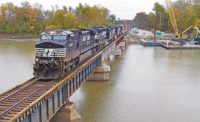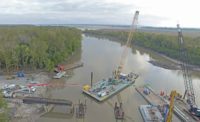To create an ingress to the western side of Liberty University's campus, a new roadway was constructed under Norfolk Southern rail lines. The design called for two 2,100-ton cast-on-site reinforced concrete box tunnels that are 20.5 ft high, 32 ft wide and 130 ft long.
Rather than a conventional box tunnel jacking method, the team pulled the box tunnels through the existing railroad embankment via post-tensioning tendons installed through the embankment and walls of the tunnels.
The six 765-ton capacity jacks were mounted on 4-ft-thick reinforced concrete blocks, cast against a 23-ft-high soldier pile reaction wall located at the receiving side of the embankment. The tunnel was jacked to within 35 ft of the reaction wall and was daylighted during demolition of the reaction wall.
During tunnel jacking, the team observed that up to 60% of the face directly below the two main active rail lines consisted of cobble- to boulder-size rocks with sandy clay infill along an approximately 50-ft reach of the tunnel. These conditions were not discovered during subsurface exploration due to access restrictions to the active rail lines.
During jacking of the first tunnel, the jacks were mounted on reaction blocks at the far side of the embankment while anchoring the cables to the rear of the box tunnel—thus pulling the tunnel into place. The rock obstructions caused some minor misalignment of the tendon casings that presented problems during jacking of the first box.
As the cables were pulled through the misaligned casing, the friction between the two caused the casing to be pulled toward the jack, buckling the casing. The team overcame this by hand mining 4-ft by 4-ft box tunnels along the lower tendons and correcting the casing alignment.
For the second box, the system was reversed with jacks mounted on the rear of the box. System reversal created a condition where the tendons remained static relative to the casing installed through the embankment; this allowed movement of the tendons relative to the casing within the box tunnel walls. The process reduced the potential for the casing to buckle within the embankment.
The second tunnel was jacked within 84 hours, while the first box took 12 days to install. During the jacking operations for both tunnel sections, all parties—including the contractor, the owner's design engineer and Norfolk Southern's engineer—maintained a 24-hour work schedule.
Subsequent to installation of the tunnels, separate contracts were awarded for construction of permanent retaining/wing walls, paving, electrical and restoration.
Given the atypical nature of the project, several project-specific practices and provisions were implemented to ensure safety. Steel shields were built over the ends of the jacks to divert the high tensions cables toward the ground in case they were to pop loose. On the second box tunnel, instead of pulling from the dead side, the jacks were placed on the live load side to greatly reduce drag and intense friction. Doing so reduced the potential to break cables.
Also, by pulling from the live side, work crews greatly improved lines of communication because operators of the pulling jacks were on the same side as the tunneling operations. These methods helped contribute to the project's injury-free safety record.
Best Safety Project and Best Small Project (under $10 million) - Twin Vehicular Tunnels Beneath Norfolk Southern Railroad, Lynchburg, Va.
Key Players
Owner Liberty University
Lead Design Firm Brierley Associates
General Contractor Southland Contracting
Structural Design Elwyn & Palmer Consulting Engineers
Consulting Engineer to Norfolk Southern Railroad TGS Engineers






Post a comment to this article
Report Abusive Comment